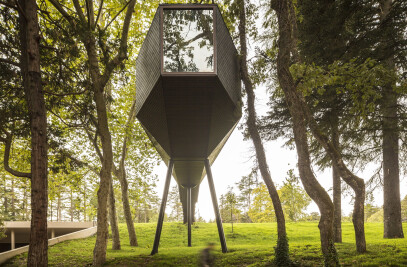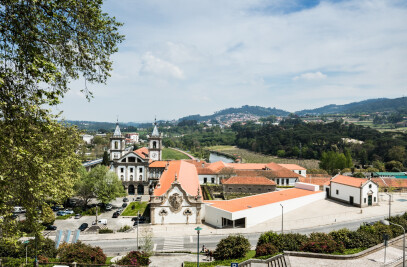The Nadir Afonso Foundation,built in the city of Chaves, in a terrain located on the right bank of the Tâmega river, had its detailed planning elaborated within the ambit of the Polis programme.
The area destined to the building is located at the place of Longras, in the civil parish of Santa Maria Maior,and was established in the plan as a rectangle parallel to the riverbed,inside the future marginal park, between the new footpath/bike laneparallel to the 5 de Outubro avenue(northwest), the Dr. Mário Soares avenue(northeast), the new street layout parallel to the Longras street (southwest) and the river (southeast).
The main floor of the foundation building is placed over a concrete platform, 351,50 height, supported by walls perpendicular to the river, in order to prevent an eventual flood. The risk of an eventual flood should not be excluded. The height difference between the northwest street layout and the natural terrain is balancedby means of a ramp with a slight slop.
The main access to the foundation platform is made by means of a slight ramp with a slop of 6%, from the sidewalk,at height 349,13(non-floodable height). Furthermore,two elevators and two staircases have been projected, from the ground, southwest (public access) and northeast (service access, loading and unloading). In a more central positioning, by the access to theexhibition spaces, there is a third staircasedesigned as an emergency exit.
The internal programmed spaces are conceivedlongitudinally in three sectors: a) atrium, reception, public elevator (13p.), library, auditorium with a seating capacity for 100 people, cloakroom,restrooms, bookstore and cafeteria, at the southwest top of the building.
b) exhibition spaces, in the central zone, subdivided into 3 longitudinal wings and including both a permanent exhibition room and an archive (northwest wing), temporary exhibition rooms (central and southeast wings).
The exhibition room in the central wing (8,70x36,5m), which can be asymmetrically subdivided into two(8,70x12,50+8,70x23,85m), has a continuous clerestory allowing both natural and electrical light; the exhibition room in the southeast wing will be illuminatedby means of a continuous horizontal openingover the river orby coving. The temporary exhibition roomwill not have general natural lightbut only an opening over the yardthat limits it.
c) the northeast top of the buildingincludes acontrol and security center, a hoist (3,45x2,5m), a service staircase, areceptionand accessto the archives (northwest); restrooms, a staff room andadministration areas (southeast); a plastic arts room and Nadir Afonso studio (with zenithal light and river view).
In the upper floor, which can be accessed through thecontrol and security center, there is a set of technical spaces (interior and exterior balcony),from which is made easier the access to the skylights and to a second technical spacelocated over the auditorium.
The building is built with apparent structural white concrete walls; the roof is covered almost completely with pebbles,and the top of the skylights and the machine roomis covered withzinc plate. The essential interior finisheswill consist in wood floors, plasterboard on the walls and ceilings and white marbleon the water zones. The interior window frames will be made of wood and stainless steel; the exterior ones will be made of wood and aluminum.
The exterior floors are composed of granite on the stairs and the access floor;and white marble on the balconies. Concerning thelandscape project, the proposal includes the cleaning and consolidation of the ruins of the Longras alley, similarly to what wasrecently done on the banks of the Tâmega river, and the preservation of some existing fruit trees. As a means of helping the outdoor activities promoted by the foundation, there is a plan to cover almost completely the ground with a meadow, except with regard to the natural soil that corresponds to the projection of the building, in which an carpet of ivy should be installed. The arboreal and shrubby vegetationwhich was proposedwill be mostly composed of autochthonous species, preferably from propagulescollected locally or regionally. Its use is intended tocreate massive aggregates of vegetation capable of generating non-pruned hedges for protection,necessary to the organization and reading of the space.
The accessibility and exclusive area plandesigned for disabled people, as well as the indication of parking spots, is presented in drawing on page 5.
By the main access to the Foundation, in the Northwest street layout, 2 parking spots will be made available for disabled people, who can access the building using the ramp with a slop of 6%. Besides, it’s being projecteda parking lot with 4 more spots located Southwest. This route could be developed, alongside the shorter path, at the level of the natural soil. The access to the building will be made through an elevator.
The programme of the Foundationis developed in a single floor. The still steps, located on the access to the building, are never higher than 2cm. There should be 2 places exclusive for disabled people on the auditorium, leveled with the access to the space. The sanitary facilities for general use have spaces reserved for disabled people.
The building is in accordance with the Detailed Planning of the Banks of the Tâmegaand respects the urbanistic parameters in force according to theM.D.P. of theTown Hall of Chaves, whose general values are.

































